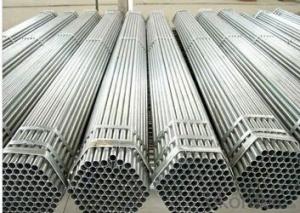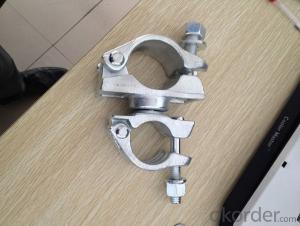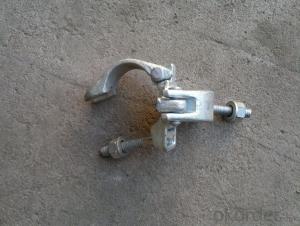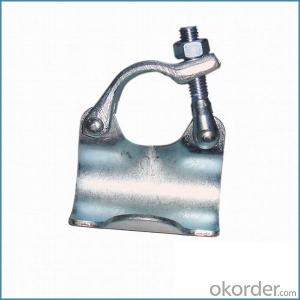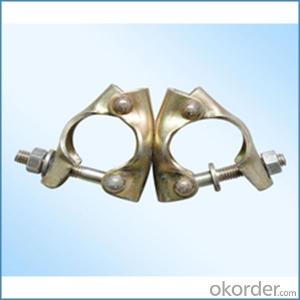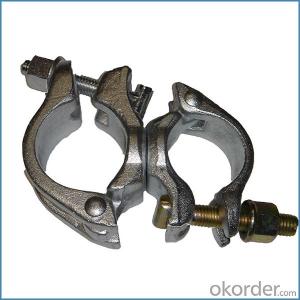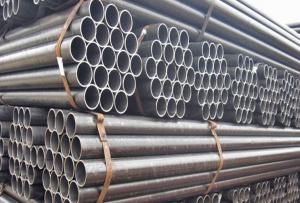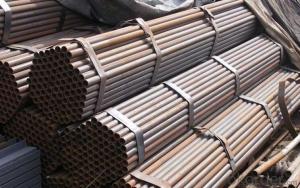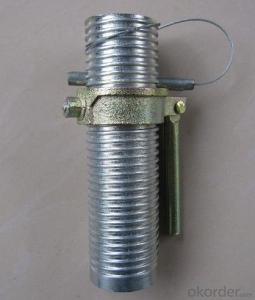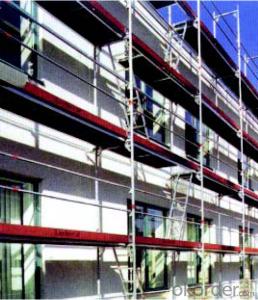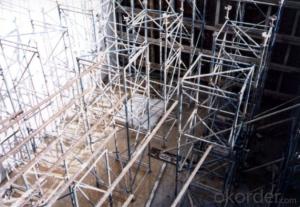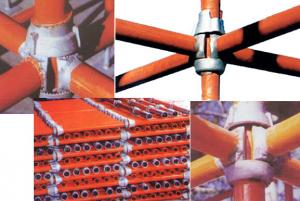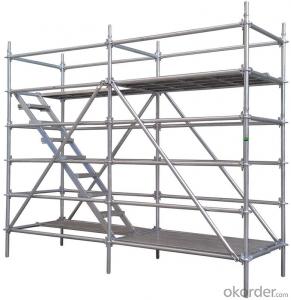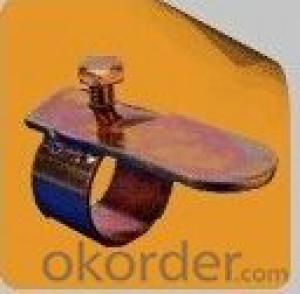Scaffolding Double Clamp british German Forged Type
- Loading Port:
- Tianjin
- Payment Terms:
- TT OR LC
- Min Order Qty:
- 1000 kg
- Supply Capability:
- 100000 kg/month
OKorder Service Pledge
OKorder Financial Service
You Might Also Like
Scaffolding Double Clamp british German Forged Type
Description
1.The scaffolding coupler is always used to connect the steel pipe as scaffolding system.
2.The often used coupler is swivel coupler and righ angle coupler .
3.We can provide types of scaffolding coupler according to your requirement.
4.Couoler can fix the 48.3mm scaffolding steel pipe tightly and make the whole scaffolding system more steadily.
Feature
(1)Excellent Anti-Breaking—Cold Pressed Steel
(2)Outstanding Resistance Deformation
(3)Strong Anti-Dropping Ability
Photo

Parameter
| Material | Q235,345steel |
| Size | 48.3mm*48.3mm |
| Surface finish | Galvanized |
| Weight | 1.1kg around |
| Standard | BS1139,EN74 |
| Package | 25pcs/bag,steel pallet |
| Manufacture | As per customer requirement |
| Market | Africa, South America, the Middle East and Asia |
FAQ
Q: Are you a factory or trading company?
We are a state-owned corporation in China,dealing with various kinds of building materials.We have our holding subsidiaries.
Q: Where is your factory located? How can I visit there?
Our factory is located all around China.
Q: Can I get some samples?
Sample is free, customer only pay freight for the first time.
Q: Delivery?
10-30days. (5-15 containers)
Any question,feel free to contact us.
- Q:How do steel tube couplers prevent tubes from sliding vertically?
- Steel tube couplers prevent tubes from sliding vertically by providing a secure and stable connection between two tubes. These couplers consist of a cylindrical sleeve with internal threads that can be tightened around the tubes to create a strong bond. The key mechanism that prevents vertical sliding is the friction created between the coupler and the tubes. As the coupler is tightened, it compresses the tubes together, increasing the contact area and creating a higher level of friction. This frictional force resists any vertical movement of the tubes, effectively locking them in place. Additionally, the design of the coupler plays a crucial role in preventing vertical sliding. The internal threads of the coupler are usually tapered, which helps to exert an even pressure on the tubes when tightened. This ensures a uniform compression and maximizes the frictional force between the coupler and the tubes, making it harder for them to slide vertically. Furthermore, the materials used in steel tube couplers are specifically chosen for their high strength and durability. Steel is known for its excellent load-bearing capabilities, and this strength is crucial in preventing any vertical movement of the tubes, especially under heavy loads or in dynamic environments. In summary, steel tube couplers prevent tubes from sliding vertically by utilizing frictional forces and a secure, tight connection between the tubes. The compression, tapering, and high-strength materials of the coupler all contribute to ensuring a stable and immovable joint, providing safety and reliability in various applications such as scaffolding, construction, and engineering projects.
- Q:How do steel tube couplers contribute to the overall durability of scaffolding structures?
- Steel tube couplers play a crucial role in enhancing the overall durability of scaffolding structures. These couplers are designed to securely connect steel tubes together, creating a stable framework that can withstand heavy loads and adverse weather conditions. One of the key contributions of steel tube couplers to the durability of scaffolding structures is their ability to provide strong and reliable connections. These couplers are usually made from high-quality steel, which ensures their strength and long-term durability. When properly installed, they create a solid and rigid connection between the tubes, preventing any movement or dislodging that could compromise the stability of the structure. This ensures that the scaffolding can support the weight of workers, materials, and equipment without any risk of collapse. Furthermore, steel tube couplers are designed to distribute the load evenly across the connected tubes. This helps in preventing stress concentration at particular points, which can lead to structural weaknesses and potential failure. By evenly distributing the load, the couplers contribute to the overall strength of the scaffolding structure, making it more resistant to deformation and bending. Another significant contribution of steel tube couplers is their ability to provide versatility and flexibility in scaffolding design. These couplers allow for various configurations and adjustments, enabling scaffolding structures to adapt to different project requirements and site conditions. Whether it is a simple straight structure or a complex arrangement with corners and angles, the couplers ensure that the scaffolding can be easily assembled, disassembled, and reconfigured without compromising its durability. Moreover, steel tube couplers are known for their resistance to corrosion and degradation. They are often coated with protective layers such as galvanization, which prevents rusting and corrosion caused by exposure to moisture and other environmental factors. This improves the longevity of the couplers and, consequently, the overall durability of the scaffolding structure. In conclusion, steel tube couplers contribute significantly to the overall durability of scaffolding structures. Their strong and reliable connections, load distribution capabilities, versatility, and resistance to corrosion help ensure that the scaffolding can withstand heavy loads, adapt to different configurations, and remain stable and secure throughout its lifespan.
- Q:Can steel tube couplers be used in scaffolding projects involving complex or intricate geometries?
- Scaffolding projects with complex or intricate geometries can indeed utilize steel tube couplers. These couplers possess great versatility, enabling the seamless connection of diverse scaffolding components. This, in turn, facilitates the creation of various shapes and configurations, granting much-desired flexibility. Their design specifically caters to securely joining tubes at different angles and positions, thereby allowing for the construction of scaffolding structures with complex or intricate designs. Moreover, the strength and durability of steel tube couplers have earned them a commendable reputation, rendering them highly suitable for supporting scaffolding systems in demanding environments. Therefore, they serve as a dependable choice for scaffolding projects that entail complex or intricate geometries.
- Q:I want to get a piercing before school starts (on the 17th). I'm getting it next Friday but I'm not sure which one would be better to get. Which one would be less sore/painful after 4 days? And my ears are really small and I have a super thick cartilage so would they still be able to pierce it / would there be a greater chance of infection if I get the industrial ? Help pleaseeee
- Belly Button > Industrial. The industrial will have 2 holes to heal in the cartilage, which takes longer, gets knocked more and I would guess it would get infected, quite easily. Plus your ears don't sound like the right fit. I have my navel pierced and it was pretty fast. It doesn't hurt too much while it's healing, but if you knock it with a towel or something after a shower, it hurts like a *****. Ultimately, it's your choice, but I'd say belly button.
- Q:How do you dismantle and remove steel tube couplers from scaffolding?
- To dismantle and remove steel tube couplers from scaffolding, you will need a few tools and follow a systematic approach. Here are the steps involved: 1. Gather the necessary tools: You will need a hammer, a wrench, and a scaffold spanner. Make sure you have the appropriate sizes for these tools to match the couplers you are working with. 2. Assess the scaffolding structure: Before starting the dismantling process, evaluate the scaffolding structure to identify the couplers you need to remove. Take note of their locations and understand how they are connected to the tubes. 3. Loosen the coupler nuts: Using a scaffold spanner or a wrench, loosen the nuts that secure the couplers to the tubes. Turn them counterclockwise to release the grip. In some cases, you may need to tap the spanner gently with a hammer to loosen stuck or rusted nuts. 4. Remove the coupler nuts: Once the nuts are loosened, carefully unscrew them completely and set them aside. Be cautious not to drop them as they could be lost or cause injury if they fall from a height. 5. Separate the scaffolding tubes: Once the nuts are removed, you can now separate the scaffolding tubes by pulling them apart. You may need to wiggle or twist the tubes slightly to break any residual friction. 6. Remove the couplers: With the tubes separated, you can now remove the couplers from the scaffolding structure. Grasp the coupler firmly, and using a hammer, tap it gently from the side or underneath to dislodge it. If necessary, use a pair of pliers to provide additional leverage. 7. Repeat the process: Continue this process for each coupler you need to remove from the scaffolding structure. Take your time to ensure each step is executed safely and effectively. 8. Inspect and replace: After removing the couplers, inspect them for any damage or wear. If any couplers are broken or show signs of deterioration, they should be replaced before reassembling the scaffolding. Remember, safety should always be a priority when working with scaffolding. Ensure the structure is stable and secure, use appropriate personal protective equipment, and follow any specific guidelines provided by the manufacturer or your supervisor.
- Q:Are steel tube couplers suitable for supporting platforms or decking on scaffolding?
- Steel tube couplers are a great option for supporting platforms or decking on scaffolding. Designed to securely connect steel tubes, they offer a strong and reliable connection. These couplers are frequently used in scaffolding systems to create a stable platform for workers to reach higher areas. Not only are they durable and capable of handling heavy loads, but they are also easy to install and can be adjusted to different angles and positions. This flexibility allows for various scaffolding designs. In summary, steel tube couplers are a reliable and efficient choice for supporting platforms or decking on scaffolding.
- Q:Are steel tube couplers resistant to corrosion and weathering?
- Yes, steel tube couplers are resistant to corrosion and weathering due to their protective coatings or galvanized finishes. These coatings provide a barrier against moisture, oxidation, and other environmental elements, ensuring the longevity and durability of the couplers.
- Q:Can steel tube couplers be used in scaffolding projects with limited access to power sources?
- Yes, steel tube couplers can be used in scaffolding projects with limited access to power sources. Steel tube couplers are mechanical fittings that allow steel tubes to be connected together to form a scaffold structure. They do not require any power source to be used as they rely on manual tightening of bolts or clamps to secure the tubes in place. This makes them a versatile and convenient option for scaffolding projects in remote or off-grid locations where power sources may be limited or unavailable. Additionally, steel tube couplers are known for their strength and durability, making them suitable for use in various construction or maintenance projects.
- Q:How do steel tube couplers prevent slippage or loosening of scaffolding connections over time?
- Steel tube couplers are specifically designed to prevent slippage or loosening of scaffolding connections over time. These couplers consist of a cylindrical body with internal teeth or gripping mechanisms that securely hold the tubes together. One way they prevent slippage is by providing a tight fit between the tubes. When the coupler is tightened, it creates a strong connection by compressing the tubes together, ensuring there is no room for movement or slippage. This tight fit prevents any loosening of the connection, even under heavy loads or vibrations. Additionally, steel tube couplers often have a locking mechanism that further enhances the stability of the connection. The locking mechanism can be in the form of a bolt or a pin that is inserted through the body of the coupler, effectively locking the tubes in place. This adds an extra layer of security and prevents any potential slippage or loosening over time. Moreover, steel tube couplers are usually made from high-quality, durable steel materials. These materials are known for their strength and resistance to wear and tear. This durability ensures that the couplers can withstand the forces and pressures exerted on the scaffolding connections over time, without compromising their performance. In summary, steel tube couplers prevent slippage or loosening of scaffolding connections over time by providing a tight fit between the tubes, incorporating a locking mechanism, and utilizing durable materials. These features work together to create a stable and secure connection that can withstand the demands of construction and ensure the safety of workers.
- Q:Can steel tube couplers be used in scaffolding projects with complex geometries?
- Yes, steel tube couplers can be used in scaffolding projects with complex geometries. Steel tube couplers are versatile and can be used to connect tubes at various angles, allowing for the creation of scaffolding structures that can adapt to complex shapes and configurations.
1. Manufacturer Overview |
|
|---|---|
| Location | |
| Year Established | |
| Annual Output Value | |
| Main Markets | |
| Company Certifications | |
2. Manufacturer Certificates |
|
|---|---|
| a) Certification Name | |
| Range | |
| Reference | |
| Validity Period | |
3. Manufacturer Capability |
|
|---|---|
| a)Trade Capacity | |
| Nearest Port | |
| Export Percentage | |
| No.of Employees in Trade Department | |
| Language Spoken: | |
| b)Factory Information | |
| Factory Size: | |
| No. of Production Lines | |
| Contract Manufacturing | |
| Product Price Range | |
Send your message to us
Scaffolding Double Clamp british German Forged Type
- Loading Port:
- Tianjin
- Payment Terms:
- TT OR LC
- Min Order Qty:
- 1000 kg
- Supply Capability:
- 100000 kg/month
OKorder Service Pledge
OKorder Financial Service
Similar products
New products
Hot products
Related keywords




